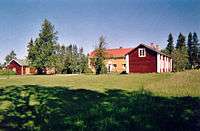Pajala Municipality
| Pajala Municipality Pajala kommun | ||
|---|---|---|
| Municipality | ||
| ||
 | ||
| Country | Sweden | |
| County | Norrbotten County | |
| Seat | Pajala | |
| Area[1] | ||
| • Total | 8,050.73 km2 (3,108.40 sq mi) | |
| • Land | 7,840.19 km2 (3,027.11 sq mi) | |
| • Water | 210.54 km2 (81.29 sq mi) | |
| Area as of January 1, 2014. | ||
| Population (June 30, 2016)[2] | ||
| • Total | 6,186 | |
| • Density | 0.77/km2 (2.0/sq mi) | |
| Time zone | CET (UTC+1) | |
| • Summer (DST) | CEST (UTC+2) | |
| ISO 3166 code | SE | |
| Province | Norrbotten | |
| Municipal code | 2521 | |
| Website | www.pajala.se | |
Pajala Municipality (Swedish: Pajala kommun; Finnish: Pajalan kunta) is a municipality in Norrbotten County in northern Sweden, bordering Finland. Its seat is located in the locality of Pajala.
In 1884 Tärendö was detached from Pajala Municipality, forming a municipality of its own. In 1914 Pajala Municipality was once again split when Junosuando broke away. They were reunited in 1971, when Korpilombolo was added as well.
History
Its geographical location means that Pajala Municipality has always been a natural trading place, where people from Sweden, Finland and the native Sami people gathered. The annual Pajala market traces its history from the 18th century.

The home of Lars Levi Læstadius, famed botanist and Christian revivalist movement founder is located in Pajala. It is the red house to the right; it is now a museum. The yellow house in the middle was used as the local Lutheran vicar's mansion from 1850 up to recent times.
Geography
The municipality is one of Sweden's largest, geographically, at around 8,000 km², or roughly the size of the historical province of Södermanland, which - compared to Pajala Municipality's population of approximately 6,500 - has more than one million inhabitants.
In Pajala is also Jupukkamasten, a 335 metre tall guyed mast for FM- and TV-transmission, which together with three other guyed masts of the same height is the tallest structure in Sweden.
Localities
There are four localities (or urban areas) in Pajala Municipality:[3]
| # | Locality | Population |
|---|---|---|
| 1 | Pajala | 1,985 |
| 2 | Korpilombolo | 548 |
| 3 | Junosuando | 345 |
| 4 | Kangos | 278 |
The municipal seat in bold
Government and politics
Distribution of the 33 seats in the municipal council after the 2010 election:
- Social Democratic Party 18
- Left Party 7
- Christian Democrats 3
- Moderate Party 2
- Norrbottens Sjukvårdsparti 2
- Centre Party 1
Results of the Swedish general election, 2010 in Pajala:
- Social Democratic Party 51.3%
- Left Party 18.8%
- Moderate Party 12.6%
- Christian Democrats 5.5%
- Sweden Democrats 3.9%
- Centre Party 3.2%
- Liberal People's Party 2.1%
- Green Party 2.1%
Sister cities
Pajala Municipality has three sister cities:[4]
References
- ↑ "Statistiska centralbyrån, Kommunarealer den 1 januari 2014" (Microsoft Excel) (in Swedish). Statistics Sweden. Retrieved 2014-04-18.
- ↑ "Folkmängd i riket, län och kommuner 30 juni 2016" (in Swedish). Statistics Sweden. August 17, 2016. Retrieved August 17, 2016.
- ↑ Statistics Sweden as of December 31, 2005
- ↑ Official site (Swedish)
External links
| Wikimedia Commons has media related to Pajala Municipality. |
- Pajala Municipality - Official site
- World's largest sundial in Pajala
Coordinates: 67°11′N 23°22′E / 67.183°N 23.367°E
